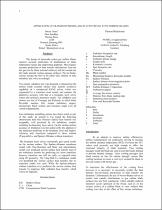JavaScript is disabled for your browser. Some features of this site may not work without it.
- ResearchSpace
- →
- Research Publications/Outputs
- →
- Conference Publications
- →
- View Item
| dc.contributor.author |
Dunn, Dwain I

|
|
| dc.contributor.author |
Snedden, Glen C

|
|
| dc.contributor.author |
Roos, T

|
|
| dc.contributor.author |
Hildebrandt, T

|
|
| dc.date.accessioned | 2011-11-24T10:03:23Z | |
| dc.date.available | 2011-11-24T10:03:23Z | |
| dc.date.issued | 2011-09 | |
| dc.identifier.citation | Dunn, D, Snedden, GC et al. 2011. Application of transition modelling in CFD for use with turbine blades. 20th ISABE Conference, Gothenburg, Sweden, 12-16 September 2011 | en_US |
| dc.identifier.uri | http://hdl.handle.net/10204/5332 | |
| dc.description | 20th ISABE Conference, Gothenburg, Sweden, 12-16 September 2011 | en_US |
| dc.description.abstract | The design of internally-cooled gas turbine blades requires accurate predictions of distributions of blade temperature values and temperature gradients. This requires accurate predictions of heat transfer distributions from the hot gas (on the blade external surfaces) and the coolant (on the blade internal cooling passage surfaces). Navier-Stokes solvers assume the flow to be either fully laminar or fully turbulent, and solve accordingly. Four turbulence modelling options have been tested as part of this study. In general it was found the following observations held true. Pressure surface heat transfer was acceptably well predicted by all turbulence models, including the boundary layer solver. On the suction surface accuracy of prediction was best achieved by the addition of the transition model (as in the boundary layer and Spalart-Allmaras with transition) compared to those without (Yang-shih k-e and Spalart-Allmaras without transition). | en_US |
| dc.language.iso | en | en_US |
| dc.publisher | American Institute of Aeronautics and Astronautics | en_US |
| dc.relation.ispartofseries | Workflow request;7555 | |
| dc.subject | Turbine blades | en_US |
| dc.subject | Transition modelling | en_US |
| dc.subject | Heat transfer | en_US |
| dc.subject | Turbulence | en_US |
| dc.title | Application of transition modelling in CFD for use with turbine blades | en_US |
| dc.type | Conference Presentation | en_US |
| dc.identifier.apacitation | Dunn, D. I., Snedden, G. C., Roos, T., & Hildebrandt, T. (2011). Application of transition modelling in CFD for use with turbine blades. American Institute of Aeronautics and Astronautics. http://hdl.handle.net/10204/5332 | en_ZA |
| dc.identifier.chicagocitation | Dunn, Dwain I, Glen C Snedden, T Roos, and T Hildebrandt. "Application of transition modelling in CFD for use with turbine blades." (2011): http://hdl.handle.net/10204/5332 | en_ZA |
| dc.identifier.vancouvercitation | Dunn DI, Snedden GC, Roos T, Hildebrandt T, Application of transition modelling in CFD for use with turbine blades; American Institute of Aeronautics and Astronautics; 2011. http://hdl.handle.net/10204/5332 . | en_ZA |
| dc.identifier.ris | TY - Conference Presentation AU - Dunn, Dwain I AU - Snedden, Glen C AU - Roos, T AU - Hildebrandt, T AB - The design of internally-cooled gas turbine blades requires accurate predictions of distributions of blade temperature values and temperature gradients. This requires accurate predictions of heat transfer distributions from the hot gas (on the blade external surfaces) and the coolant (on the blade internal cooling passage surfaces). Navier-Stokes solvers assume the flow to be either fully laminar or fully turbulent, and solve accordingly. Four turbulence modelling options have been tested as part of this study. In general it was found the following observations held true. Pressure surface heat transfer was acceptably well predicted by all turbulence models, including the boundary layer solver. On the suction surface accuracy of prediction was best achieved by the addition of the transition model (as in the boundary layer and Spalart-Allmaras with transition) compared to those without (Yang-shih k-e and Spalart-Allmaras without transition). DA - 2011-09 DB - ResearchSpace DP - CSIR KW - Turbine blades KW - Transition modelling KW - Heat transfer KW - Turbulence LK - https://researchspace.csir.co.za PY - 2011 T1 - Application of transition modelling in CFD for use with turbine blades TI - Application of transition modelling in CFD for use with turbine blades UR - http://hdl.handle.net/10204/5332 ER - | en_ZA |






